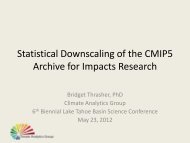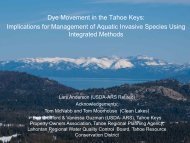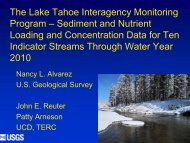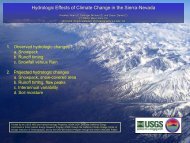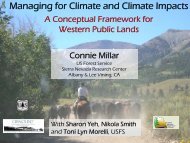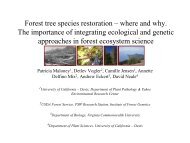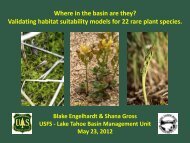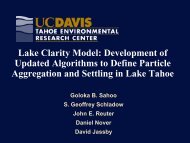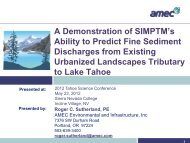Stumpner, Paul
Stumpner, Paul
Stumpner, Paul
You also want an ePaper? Increase the reach of your titles
YUMPU automatically turns print PDFs into web optimized ePapers that Google loves.
Physical Exchange Processes in<br />
Emerald Bay Lake Tahoe, CA-NV<br />
<strong>Paul</strong> <strong>Stumpner</strong>, Alex Forrest, and Geoff Schladow<br />
UCD Tahoe Environmental Research Center (TERC) - Incline Village, NV<br />
UCD Environmental Dynamics Laboratory – Davis, CA<br />
May 23, 2012
Emerald Bay<br />
• Small Embayment ~ 0.097 km 3<br />
• Lake Tahoe ~ 150 km 3<br />
• Sill formed by glacial moraine<br />
separates EB and Lake Tahoe<br />
• Water Characteristics<br />
(particulates, dissolved matter,<br />
etc.) different than Lake Tahoe
July 22, 2011 @ 1300
Study Motivation<br />
• Pilot Study - rubber bottom barriers to control<br />
Corbicula Fluminea (Asian Clams)*<br />
• Dissolved Oxygen (DO) did not reach near anoxic<br />
condition under barriers*<br />
• 20 – 80 % saturation for study duration<br />
• Investigate Processes behind Observations<br />
• Field Experiment May – September 2011<br />
• Investigations Ongoing<br />
*Gamble, Allison. Asian Clam Populations in Emerald Bay:<br />
Initial Ecology Results and Future Investigations
Emerald Bay Field Experiment<br />
2 Moorings - Inside (~15m)<br />
and Outside (~30m) of EB<br />
• Acoustic Doppler Current<br />
Profiles (ADCP’s)<br />
• Thermistor Chains<br />
At the sill (3m)<br />
• Acoustic Doppler<br />
Velocimeter (ADV)<br />
• Pressure Sensor<br />
• DO sensors above and<br />
below barrier mat
Emerald Bay Field Experiment<br />
Underwater Photo: Courtesy of Brant Allen
Hypotheses for Observed DO<br />
1. Exchange of water increases DO under barrier<br />
‣ Flow directly under mat<br />
‣ Flow initiates substrate (hyporheic) flow<br />
2. Wave Pumping due to High Boat Traffic or Daily<br />
Winds<br />
3. Eagle Creek run-off displaces water at sill
Exchange Flow Mechanisms<br />
Horizontal Temperature Gradients<br />
• Differential heating and cooling<br />
• Surface layer stirring by weak-moderate winds<br />
T 1<br />
T 2<br />
T 1 > T 2<br />
Lake Tahoe<br />
Emerald Bay
Exchange Flow Mechanisms<br />
Strong Winds<br />
• Initially produces surface seiching<br />
• Cooler water upwells outside of EB<br />
U<br />
T 1<br />
T 1 T 2<br />
T 2<br />
T 1<br />
T 2<br />
T 1 > T 2<br />
T 2<br />
Lake Tahoe<br />
Emerald Bay
Field Observations
Exchange Mechanism –Temperature Gradients
Diurnal DO Fluctuations
Exchange Mechanism - Upwelling
DO Supply from Upwelling Events
Conclusions<br />
‣Peaks in DO - Upwelling events initiate<br />
exchange flow and supply DO from Lake Tahoe<br />
to 80-85% saturation<br />
‣Diurnal DO Fluctuations - Daily boat traffic,<br />
winds, and exchange flows all contribute<br />
‣Flow pathways either directly under mat or<br />
through substrate – Still under investigation!
Acknowledgements<br />
Funding Agencies<br />
• California State Parks, Tahoe Region<br />
Planning Agency, Tahoe Resource<br />
Conservation District, and the California<br />
Tahoe Conservancy<br />
TERC Staff and UC Davis Students<br />
• Brant Allen, Katie Webb, Allison Gamble,<br />
Raph Townsend, Kristen Fauria, Kristin<br />
Reardon, and Daniel Nover




